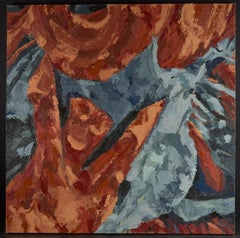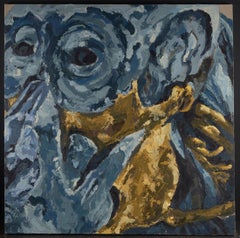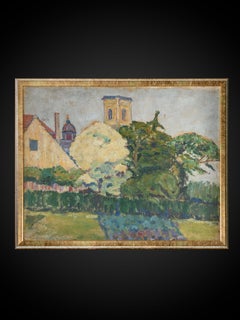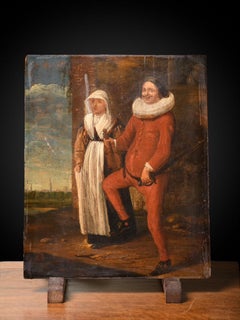Want more images or videos?
Request additional images or videos from the seller
1 of 14
17th C, Baroque, Hunting Scene, Wild Boar Hunt in the style of Frans Snijders
$15,052.33List Price
About the Item
- Attributed to:Jan van Kessel (1626 - 1679, Belgian)
- Dimensions:Height: 26.19 in (66.5 cm)Width: 39.18 in (99.5 cm)Depth: 1.78 in (4.5 cm)
- Medium:
- Movement & Style:
- Period:
- Condition:
- Gallery Location:brussel, BE
- Reference Number:Seller: 12901stDibs: LU150927941942
About the Seller
5.0
Vetted Professional Seller
Every seller passes strict standards for authenticity and reliability
1stDibs seller since 2021
15 sales on 1stDibs
Authenticity Guarantee
In the unlikely event there’s an issue with an item’s authenticity, contact us within 1 year for a full refund. DetailsMoney-Back Guarantee
If your item is not as described, is damaged in transit, or does not arrive, contact us within 7 days for a full refund. Details24-Hour Cancellation
You have a 24-hour grace period in which to reconsider your purchase, with no questions asked.Vetted Professional Sellers
Our world-class sellers must adhere to strict standards for service and quality, maintaining the integrity of our listings.Price-Match Guarantee
If you find that a seller listed the same item for a lower price elsewhere, we’ll match it.Trusted Global Delivery
Our best-in-class carrier network provides specialized shipping options worldwide, including custom delivery.You May Also Like
Van der Bent, Southern Landscape with woman animals, Dutch Old Master, Berchem
Located in Greven, DE
17th Century Old Master, Figurative and Landscape Painting by Jan Van der Bent
So far, little is known about the life and work of Jan van der Bent. He was...
Category
17th Century Baroque Landscape Paintings
Materials
Canvas, Oil
$17,821 Sale Price
20% Off
H 34.26 in W 29.53 in
Large Oil Painting "Baroque Style Manor Scene with Horse and Dogs in Landscape"
By Martha Ochoa
Located in Austin, TX
24 x 36 inches
Oil on gallery wrapped canvas
unframed
An elegant classic! A Manor scene featuring humans' allies in fox hunting: a horse and three hound dogs. The piece is masterfu...
Category
Mid-20th Century Baroque Animal Paintings
Materials
Canvas, Oil
Hunting Dog with Game
By Giacomo Nani
Located in Atlanta, GA
Famous for his paintings of animals, landscapes and still lifes, Giacomo (sometimes spelled Jacopo) Nani was an Italian painter of the Baroque period. Presumably born in Naples, Nani studied under Gasparo López and Andrea Belvedere whose style Nani often imitated. Nani became famous while working in the court of Charles of Bourbon, future Charles III of Spain (1716 – 1788). His work is featured in the collections of museums worldwide, especially his hometown museum in Naples. An excellent example of his work, this painting is signed in the lower left corner "Giacomo Nani."
This painting depicts a hunting dog...
Category
18th Century and Earlier Baroque Animal Paintings
Materials
Canvas, Oil
Roaring Deer Stag, Carl Friedrich Deiker, Wetzlar 1836 – 1892 Düsseldorf, Signed
Located in Knokke, BE
Roaring Deer Stag
Deiker Carl Friedrich
Wetzlar, Germany 1836 – 1892 Dusseldorf, Germany
German Painter
Signature: Signed bottom right
Medium: Oil on canvas
Dimensions: Image size 58 x 81 cm, frame size 73 x 96 cm
Biography: Deiker Carl Friedrich was born on April 3, 1836 in Wetzlar. He was a Prussian animal painter. Deiker was specialised in animal genres related to hunting and wildlife. He also illustrated magazines and books on hunting.
Carl Friedrich Deiker was the son of Friedrich Deiker, a painter and drawing teacher at the high school. His older brother, Johannes Deiker, with whom he learned to draw after their father’s death in 1843, was a painter specialising in hunting scenes.
Deiker attended the Hanau drawing Academy, where he was a pupil of the director Theodor Pélissier (1794-1863), and then studied at Johann Wilhelm Schirmer’s studio in Carlsruhe.
In 1859, in the Reinhardswald forest, he collected studies for his large hunting paintings...
Category
19th Century Baroque Animal Paintings
Materials
Canvas, Oil
$9,874
H 28.75 in W 37.8 in D 3.94 in
Flemish 17th, Orpheus and Animals, Large Decorative Wall Old Master Painting
Located in Greven, DE
Flemish school, 17th century
Orpheus and the animals
Oil on canvas, 146,5 x 217 cm
Provenance: South German private collection.
On an impressive, room-filling format, this painting depicts "Orpheus and the Animals."
The harp-playing Orpheus sits centrally in front of a tree whose trunk bifurcates above his head. This central tree frames with its crown the scenery towards the horizon and at the same time offers through branches the possibility for many birds to find space. The left half of the picture is characterized by a seascape, at the edge of which the ruins of a castle can be seen deep in the background. This seascape, framed by mountains on the horizon, is the only area where sky can be seen. On this side, waterfowl such as storks, swans and ducks can be seen. In the right half, the viewer looks into a deep European forest. On this right side, more land animals can be found, such as deer, rabbits and lions, among others. Orpheus wears opulent red and gold trimmed clothing, under his blue breastplate we see a white shirt. His feet are adorned by elaborate sandals. His head is surrounded by a radiant laurel wreath ("poeta laureatus"). The young man is clearly identifiable as the singer and poet of Greek mythology, Orpheus, by his harp, the laurel wreath and the animals surrounding him.
Orpheus was one of the Argonauts who, under Jason, was searching for the Golden Fleece. He sang so beautifully that he even conquered the angry sea and enemies by the magic of his lyre. During the journey, Orpheus is said to have drowned out even the sirens with his singing. It is said that he was the greatest of all poets and charmed people, animals, stones and trees with his singing.
In total, 51 birds and 37 different species are depicted in the painting. The animals are mostly depicted in great detail and, except for a few, can be identified. Mainly European species of animals are shown. Exceptions are the ostrich-like nandu peeking out from behind the deer, as well as the large parrot on the upper left, and the two lions. Similar is the case for the large animal directly behind Orpheus on the right. The shape of the head suggests an arctic fox from the polar regions, even though the body is much too large. The arctic fox was first described in 1555 by Olaus Magnus. However, it could also be a depiction of a brown or black bear.
An unusual detail is the animal, which is relatively isolated in the right background and looks to the left. It is not clearly identifiable, but it shows certain similarities with the Australian kangaroo. This was first described by Vespucci in 1500 and further by Francisco Pelsaert in 1629. If it is indeed a kangaroo, this would be one of the earliest surviving pictorial representations.
In this painting, Orpheus is accompanied by a small monkey playing a viola da gamba. This is an iconographic peculiarity. In general, this painting has some peculiarities compared to other paintings with "Orpheus and the animals". The central positioning of Orpheus is quite common, but he usually holds a lyre and is dressed in an antique style, but not as opulently. The choice of animals is also remarkable: European animals in particular are seen, hardly any exotic features, such as camels or elephants.
The two lions in the right foreground are a quotation from Peter Paul Rubens and his depiction of "Daniel in the Lion's Den", which was realized in an engraving.
The present painting can be classified as belonging to the Flemish School of the 17th century on the basis of its painterly and compositional conception. From the circle of Jan Brueghel the Younger are numerous representations of this Orpheus - theme, which take it as an opportunity to show as many exotic animals. There are also echoes of Spanish painters such as Juan de Arellano...
Category
17th Century Baroque Landscape Paintings
Materials
Canvas, Oil
$203,439
H 57.68 in W 85.44 in
Baroque Flemish master - 17th century animal painting - Live nature turkey ducks
Located in Varmo, IT
Flemish Master (17th century) - Still Life with Peacock, Roosters, and a Cat.
97 x 135 cm unframed, 103.5 x 141 cm framed.
Oil on canvas, in an ebonized wooden frame with gilt trim...
Category
Mid-17th Century Baroque Landscape Paintings
Materials
Canvas, Oil
$11,967
Free Shipping
H 40.75 in W 55.52 in
Fine 1700's Italian Old Master Oil Painting Hunting Dogs with Game, Roman Ruins
Located in Cirencester, Gloucestershire
Artist/ School: Italian School, early 18th century
The painting is almost certainly from the circle of the Italian Baroque painter known as 'Rosa da Napoli', Jacob Roos (Rome 1682-Na...
Category
Early 18th Century Baroque Landscape Paintings
Materials
Oil
$7,582
H 22 in W 26.5 in
17th-Century Dutch Pastoral Scene Figures Cattle Goats in a Bucolic Landscape
Located in Cirencester, Gloucestershire
Pastoral Scene with Figures
Dutch Old Master, 17th century
oil on canvas, framed
Framed: 16.5 x 24 inches
Canvas : 13 x 21 inches
Provenance: private collection, UK
Condition: very g...
Category
17th Century Baroque Landscape Paintings
Materials
Oil
$3,584
H 16.5 in W 24 in D 1 in
Southern Landscape with Cows, circle of Both, Dutch 17th Century Old Master
By Jan Dirksz Both
Located in Greven, DE
Circle of Andries Both, Southern Landscape with Cows. Both moved to Italy ( Rome and Venice) where is work was influenced by the warm Italian light.
Decorative Painting
Category
17th Century Baroque Animal Paintings
Materials
Canvas
$3,371 Sale Price
20% Off
H 23.63 in W 19.69 in
Swiss Pastoral landscape Alpine valley at sunset 19th century Oil painting
Located in Stockholm, SE
Romanticism movement is well maintained here by Benedikt Franz Hess (1817-1870), Swiss / American, a painter of panoramic landscapes in a detailed transcriptive yet broadly painted s...
Category
Early 19th Century Realist Landscape Paintings
Materials
Canvas, Wood, Oil
$1,550
H 16.5 in W 13.5 in
More From This Seller
View AllExpressionism, Animal Painting, Auzoux's Troglodytes Gorilla's, Oil on Canvas.
Located in brussel, BE
Around the middle of the 19th century, the missionary Thomas Savage and the anatomist Jeffries Wyman described a new animal species – the Troglodytes Gorilla – in their Boston Societ...
Category
21st Century and Contemporary Expressionist Animal Paintings
Materials
Canvas, Oil
21st C., Expressionism, Animal Painting, Auzoux's Troglodytes Gorillas
Located in brussel, BE
Around the middle of the 19th century, the missionary Thomas Savage and the anatomist Jeffries Wyman, described a new animal species – the Troglodytes Gorilla – in their article for ...
Category
2010s Expressionist Animal Paintings
Materials
Oil
Landscape painting by Gustave Fontaine (1877-1952) , Belgium.
Located in brussel, BE
Gustave FONTAINE ( Etterbeek 1877-1952 Brussels). Sculptor–painter. Took courses in Saint-Josse-ten-Noode, continued his training at the Academy of Brussels and with the sculptor Julien Dillens...
Category
19th Century More Art
Materials
Oil
17th C painting of a peasant couple preparing for Carnival.Flemish School.
Located in brussel, BE
Preparation for Carnival: a three day festival of insatiable eating, drinking and carousing that preceded the forty days of Lent, a period of penitence when the pious drank only wate...
Category
17th Century Baroque Figurative Paintings
Materials
Oil, Wood Panel
Portrait of a Gentleman in Three-Quarter-Length, attr. Nicolaes Maes
By Nicolaes Maes
Located in brussel, BE
The 39-year-old gentleman had himself portrayed as an aristocrat in an idyllic landscape. At the time, parks and forests were environments associated with the lands and pastimes of t...
Category
17th Century Dutch School Portrait Paintings
Materials
Canvas, Oil
Gustave Fontaine (1877-1952), Selection of 2 sculptured plaster head models.
Located in brussel, BE
Gustave FONTAINE ( Etterbeek 1877-1952 Brussels). Sculptor–painter. Took courses in Saint-Josse-ten-Noode, continued his training at the Academy of Brussels and with the sculptor Julien Dillens...
Category
20th Century More Art
Materials
Wood
Recently Viewed
View AllMore Ways To Browse
Marine Art Scottish
Marine Sailing Ships
Mark Rohrig
Mel Gibson
Michael Wright
Miniature Dutch Painting
Mont St Michel
Napoleonic Wars Painting
Nathan Hale
Niek Van Der Plas
Nighttime Oil Painting
Northwest Impressionist
Norwich School Paintings
Oil Painting Bahamas
Oil Painting Majorca
Old Beach Oil Painting
Original Oil Painting Canada
Paintings Of Birch Trees



